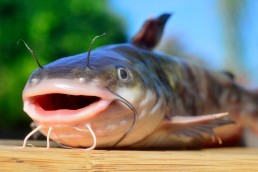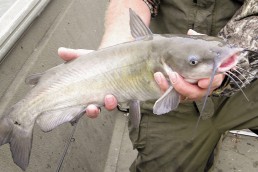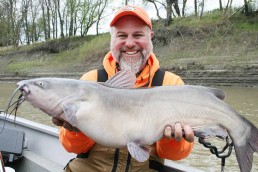Catfish in Front of Current Breaks
SHARE THIS POST
The Illinois River Hydraulic Outlook may be considered a helpful site when contemplating a trip. Normal pool is somewhere near 458 feet above sea level. Normal pool is navigable. Locations to fish are naturally available and reasonably accessible. Boat ramps are ordinarily open, and the river may be fun.
While viewing the hydraulic outlook, conditions of the previous few days as well as projections for the next few days may help to determine the speed, current and perhaps even water clarity. If the river has risen or fallen in a short amount of time, current speed may affect both boat control and fish locations. Current may push fish deep into safe hiding as well as toward shorelines and shallow obstructions. Then, too, the quicker the change in depth of the water, the possibility of particles being suspended in the water may exist. Thus, water turbidity and current speed may reduce the number of fishing locations. It may be difficult for fish to feed.
Elevation presentation
As of this writing, the pool at Ottawa was at 471 feet above sea level. That’s approximately 16 feet above normal pool. Even a 1-foot change may create a change in approach to fishing. A 5-foot change may close boat ramps and cause very limited access to the river. Remembering spring floods had a huge impact throughout the state. At 471 feet, the river had not reached its highest level as the rain continued to pour down. Previous record crests were 473.72 feet in 2013 and 472.21 feet in 2008.
As July approaches, the river conditions will be a factor to use to determine if an outing has a chance of being fun. If so, then how? If the river happens to be down to the normal 458 feet above sea level, July catfish may be on the prowl. Often very early in the morning, say around 4:30, the sun is rising and the cool of night may linger. The scorching, 96-degree summer sun is only a few hours away. The first two hours of morning is often a moment to anchor upstream of wing dams, large cement structure for barges to tie off, bridge piers as well as rock piles and riffles. Cats love to feed in the calm crevice created by water that is divided by anything in its path.
Expert advice
Of course, with such insight, the place to cast a gob of nightcrawlers or a few minnows strung on a hook and slightly mashed or a golden roach alive or any of the numerous cut or scented baits may be apparent. B&B Bait shop on the way into Ottawa from I-80 on LaSalle St. (which is also Route 23) may have just what may be needed. Ron Baudino is a distributor whose bait shop is one in a large network of shops in the Midwest. Some of all types of baits may be available. An excellent selection of tackle designed for the river, LaSalle Lake and Shabbona can be purchased as needed with bait. Maps and River information are also offered.
As casts are made into the frontal current breaks, the speed of the bai—either on a bobber or weighted by a sinker—is crucial. Too fast speeding by the area or too slow hanging up in the bottom may not be helpful to entice bites. A meandering bobber at slightly less speed than the current may get a strike by an aggressive predator. In addition, a sinker, especially the flat river sinkers on the counter at B&B may help put the bait in the haunts of feeding fish.
Are you enjoying this post?
You can be among the first to get the latest info on where to go, what to use and how to use it!
Fish on!
With bait cast to such an area as well as the rod in a holder or leaning from the floor to edge of the boat, a very relaxing form of fishing is taking place. The tip of the pole may jump slightly to communicate a nibbling and/or striking fish. In either case, hope peaks. In the best circumstances, the rod tip bends over with a battle to ensue. If action may slow down due to catching a few from the area, a longer cast to the flow of water around the obstruction, may be all that is necessary to find more fish. Initially, the front of the break may hold fish and then the flow of water around the break as well as where the flows come together downstream of the break. All may be worth checking out.
It may be 8:30 or even 9:30 by then, and the hot sun may be taking over. Perhaps a little shade may be found under the bridges, and fishing may continue. Or, a decision to seek the comfort of air conditioning may happen. The possibility of returning to the water at sunset for a couple of fun hours may also exist.
A very fun way to fish after the long, hot day subsides may be to set up a Roach or Lindy sliding, walking sinker that lets the line slide through and be unencumbered by the sinker. Minnows or whole shad can be put on the hook. Trolling motor put in the water, and a slow troll from one side of the channel to the other may take place with the pleasure of a mild summer breeze cooling the air.
Stillness and quiet during concentration of the sinker scraping bottom and the bait being taken can be a gentle, relaxing approach while enjoying the coolness of the night from a day’s work in the heat. The body may be able to release heat built up during the day.
Thus, we may be aware of both an early morning as well as dusk/evening approach during July and possible summer, scorching heat. Hopefully such heat may rest itself again this year.
Hopefully this year the river/weather may settle down. Water levels may return to 458 feet above sea level, and the River may return to a source of outdoor fun and adventure.
MWO
SHARE THIS POST
Did you enjoy this post?
You can be among the first to get the latest info on where to go, what to use and how to use it!



